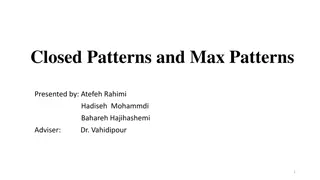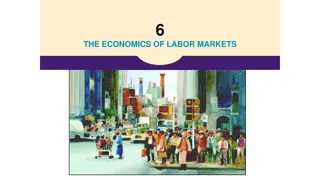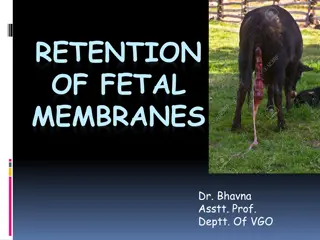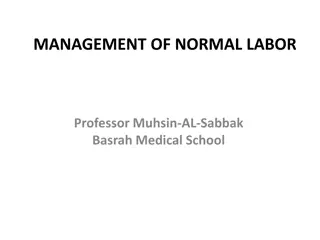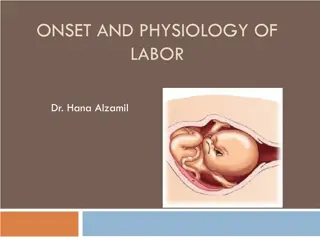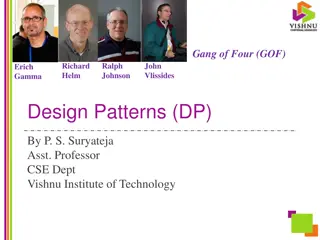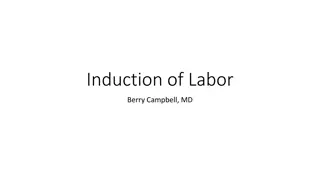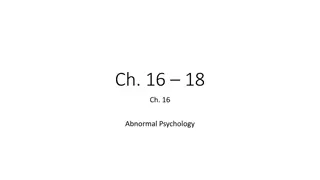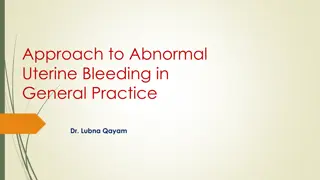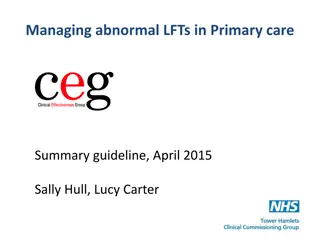Abnormal Labor Patterns and Dystocia
Abnormal labor patterns and dystocia are significant complications in childbirth. Learn about definitions, classifications, etiologies, diagnosis, and management options for these conditions. Understand the causes of dystocia: the 4 Ps, powers, passenger, passage, and psychological factors. Explore how abnormalities in contractions, fetal presentation, pelvic structure, and psychological or physician-related influences can impact the labor process.
Download Presentation

Please find below an Image/Link to download the presentation.
The content on the website is provided AS IS for your information and personal use only. It may not be sold, licensed, or shared on other websites without obtaining consent from the author.If you encounter any issues during the download, it is possible that the publisher has removed the file from their server.
You are allowed to download the files provided on this website for personal or commercial use, subject to the condition that they are used lawfully. All files are the property of their respective owners.
The content on the website is provided AS IS for your information and personal use only. It may not be sold, licensed, or shared on other websites without obtaining consent from the author.
E N D
Presentation Transcript
Learning objectives At the end of this session the students will be able to: Define abnormal labor pattern Discuss classifications of abnormal labor patterns Outline etiologies of abnormal labor patterns Discuss the diagnosis of abnormal labor patterns Describe management options of abnormal labor patterns 3
Definition of Abnormal labor Is labor that deviated from the course of the normal labor & delivery Conditions of abnormal labor can include the following Stage is not lasting in normal duration Major Maternal and fetal complications may exist Complicated pueperium May not start at term Parturition with any risk Labor may not start spontaneously Presentation is not vertex 4
Dystocia ( difficult labor): is any labor in which the pattern of labor progress is significantly different from accepted and recognized patterns of labor progress in terms of: Cervical changes Descent of fetal presenting part or Profile of uterine contractions(frequency &/or duration) It is often used interchangeably to denote an abnormal labor pattern 5
Dystocia ( difficult labor) cont Causes of Dystocia: Mainly the 4 Ps Mainly it arises from four distinct abnormalities that may exist singly or in combination: 1. Power(expulsive force) abnormalities Uterine contractions may be insufficiently strong or inappropriately coordinated to efface and dilate the cervix uterine dysfunction There may be inadequate voluntary maternal muscle effort during second-stage of labor 6
Abnormalities of the powers(expulsive forces) Abnormalities of the "powers" constitute uterine activity that is ineffective in eliciting the normal progress of labor. Ineffective uterine action characteristically falls into one of two categories: Hpotonic: with a normal pattern of low-pressure contractions Hypertonic: with a discoordinated pattern of high-pressure contractions. 7
2. Passenger abnormality Abnormalities of presentation, position, or development of the fetus 3. Passage abnormality Abnormalities of the maternal bony pelvis Pelvic contraction Abnormalities of soft tissues of the reproductive tract that form an obstacle to fetal descent 4. Psychological factor 5. Physician factor- unnecessary intervention 8
Common Clinical Findings in Women with Ineffective Labor patterns Inadequate cervical dilation or fetal descent: Protracted labor slow progress Arrested labor no progress Inadequate expulsive effort ineffective pushing Fetopelvic disproportion: Excessive fetal size Inadequate pelvic capacity Malpresentation or position of the fetus 9
Diagnosis of abnormal labor patterns - Steps Document the following parameters against time Uterine contraction profile Cervical dilatation/effacement Descent of fetal presentation Compare against normal patterns for respective parity, identify any deviations and then classify into respective abnormal patterns Look for specific etiology responsible for the abnormal labor patterns by carefully assessing the four determinants of labor progress (P s of labor) 10
Evaluation for causes of abnormal labor patterns Assessment of the four P s of labor Assessment of powers of labor: Palpation of uterine contractions External tocodynamometer Intrauterine pressure catheter monitoring 11
Assessment of the passenger Size, number, presentation, position and anomalies of the fetus by Leopold's palpations and ultrasonography Assessment of the passages Bony pelvis clinical pelvimetry Soft tissue dystocia vaginal exam Assessment of maternal emotional status and pain control 12
Mgt of abnormal labor pattern depends on specific etiology diagnosed Power abnormalities Uterine inertia Augmentation Secondary powers failure Instrumental assistance Passenger abnormalities Often caesarean deliveries required Destructive deliveries in cases of fetal deaths Abnormalities of the passages Often Caesarean delivery Episiotomy for perineal level obstruction 13
Classifications of abnormal labor patterns : Four major groups: Prolongation disorders Protraction disorders Arrest Disorders Precipitate labor 14
Prolongation Disorders Prolonged latent phase of labor Definition A latent phase lasting more than 14 hours in a multigravida and 20 hours in a primigravida Lasting more than 8 hours after true labor is diagnosed The latent phase of labor: begins with the onset of regular uterine contractions extends to the beginning of the active phase of cervical dilatation. Challenge in diagnosis due to the problem in diagnosing the exact time of onset of labor. 15
Causes of prolonged latent phase include: Excessive sedation or sedation given before the end of the latent phase Use of general anesthesia before labor enters the active phase Labor beginning with an unfavorable cervix Uterine dysfunction characterized by weak, irregular, uncoordinated, and ineffective uterine contractions, and Fetopelvic disproportion. 16
Treatment options in prolonged latent phase primarily consist of therapeutic rest regimens or active management of labor(taking an intervention). After 6 12 hours of rest with hydration, 85% of patients spontaneously enter the active phase of labor, and further progression in dilatation and effacement may be expected. 17
10% of patients : will have been in false labor and can be allowed to return home to wait for the onset of true labor if no other indications for delivery are present. In the remaining 5% of patients: uterine contractions remain ineffective in producing dilation; in the absence of any contraindication, augmentation with oxytocin infusion may be effective in progression to the active phase of labor. 18
Diagnosis and management of prolonged latent phase of labor 19
Active- phase Disorders Labor abnormalities in the active phase of labor are clinically divided into either: Slower-than-normal progress: protraction disorder or Complete cessation of progress: arrest disorder A woman must be in the active phase of labor with cervical dilatation to at least 4 cm to be diagnosed with either of these abnormalities. 20
Protraction Disorders Two protraction disorders 1.Protracted (slow rate) cervical dilatation A cervical dilatation less than 1.2 cm/hr for nulliparas and For multiparas it is defined as less than 1.5 cm/hr during active phase of labor 2. Protracted descent Descent of the fetal presentation less than 1 cm per hour for nulliparas and less than 2 cm per hour for multiparas 21
Arrest Disorders Arrest Disorders Defined as a complete cessationof dilatation or descent. Two arrest disorders 1. Arrest of Cervical Dilatation No cervical dilatation for 2 or more hours in the active phase of labor 2. Arrest of descent No descent for more than 2 hours 22
Management of abnormal active phase 1st stage of labor Management of abnormal active phase 1st stage of labor 23
Abnormalities in Second stage of labor Abnormalities in Second stage of labor Abnormalities of descent and rotation Abnormal progress in the second stage is entertained if there is no progressive descent (or head rotation to a favorable position) with each uterine contraction Progress in the second stage is monitored mainly by descent of the presenting part 24
Prolonged second stage: The median duration of 2nd stage of labor is 50 minutes in nulliparas and 20 minutes in multi parous. But arbitrary definition of prolonged 2nd stage are 2hrs in nulliparas & extended to 3 hrs when epidural anesthesia used; 1hr for multi paras and extended to 2 hrs when epidural anesthesia used. 25
The duration of 2nd stage has no relationship to perinatal out come if fetal distress and traumatic deliveries are excluded Management In the absence of fetal heart rate abnormality, if mother is well hydrated & reasonably comfortable and if there is some progress of descent or rotation regardless of how slow, there is no need for operative delivery. 26
CPD may be apparent in second stage of labor cesarean delivery is indicated in the presence of clear evidence of CPD Evaluate uterine action and if failure of descent and rotation is due to inadequate uterine action oxytocin augmentation should be done. Prolongation secondary to malpositions & malpresentation is managed according to the malposition & malpresentation diagnosed 27
Precipitate labor Precipitate labor Defined as delivery in less than 3 hours from onset of contractions. Precipitate dilatation can be defined as cervical dilatation occurring at a rate of 5 cm or more per hour Precipitate labor may result from: Extremely strong uterine & abdominal contractions Abnormally low resistance of the soft parts of the birth canal Absence of painful sensations and thus a lack of awareness of vigorous labor(rarely). The initiating mechanism for extraordinarily forceful uterine contractions usually is not known Abnormal contractions may be associated with administration of oxytocin. 28
Maternal Effects of precipitate labor Maternal complications are rare if the cervix and birth canal are relaxed However, when the birth canal is rigid and extraordinary contractions occur, uterine rupture may result Extensive Lacerations of the birth canal ( cervix, vagina, vulva, or perineum) are common The uterus that has been hypertonic with labor tends to be hypotonic in the postpartum predisposing to postpartum hemorrhage 29
Fetal and Neonatal Effects of precipitate labor Fetal and Neonatal Effects of precipitate labor Adverse perinatal outcomes from precipitous labor may be increased considerably for several reasons. The turbulent uterine contractions, often with negligible intervals of relaxation, prevent appropriate uterine blood flow and fetal oxygenation, as a result, perinatal mortality is increased secondary to possible decreased uteroplacental blood flow(hypoxia) 30
Perinatal intracranial hemorrhage may result from trauma to the fetal head pushing against unyielding maternal tissue with contractions. Finally, during an unattended birth, the newborn may fall to the floor and be injured, or it may need resuscitation that is not immediately available 31
Treatment of precipitate labor Treatment of precipitate labor If oxytocin administration is the cause of abnormal contractions, it may simply be stopped. The problem typically resolves in less than 5 minutes The patient should be placed in the lateral position to prevent compression of the inferior vena cava. 32
If excessive uterine activity is associated with FHR abnormalities and this pattern persists despite discontinuation of oxytocin, a beta-mimetic such as 125 250 mcg of terbutaline can be given by subcutaneous or slow intravenous injection if no contraindications are present. Physical attempts to retard delivery are absolutely contraindicated. 33
Obstructed labour Obstructed labour 34
Learning Objectives To define obstructed labor To list the important causes of obstructed labor To enumerate the immediate and late complications of obstructed labor. To discuss the clinical features of obstructed labor. To outline the management of obstructed labor. To discuss the prevention of obstructed labor. 35
Introduction Introduction Obstructed labor is failure of descent of the fetus in the birth canal for mechanical reasons arising from either the passage or passenger in spite of good uterine contractions. Modern Obstetric care has led to the virtual disappearance of obstructed labor in developed countries, However , in underdeveloped countries obstructed labor is a common problem. It is one of the five leading causes of direct maternal death 36
Intro.......... Intro.......... It was estimated to be the most disabling of all maternal conditions. It accounts for about 8% of maternal deaths globally. In Ethiopia we host the biggest fistula hospital in the world due to obstructed labor. Obstructed labor is an outcome of a neglected and mismanaged labor. 37
Importance is one of the major causes of maternal and perinatal mortality in developing countries. Its incidence is mainly related to the availability, accessibility and quality of ante partum and Intrapartum services in the community to a lesser extent to the incidence of fetopelvic disproportion in the community. should never occur in communities where obstetric care is optimal even if disproportion is prevalent. Therefore, is considered as a sign of major failure in obstetric care 38
Causes Causes Obstructed labor is usually an end result of improperly managed CPD Maternal causes: 1.Bony obstruction : e.g. Contracted pelvis, Abnormal shaped pelvis, Tumours of pelvic bones 2.Soft tissue obstruction Uterus myoma, Cervix - cervical dystocia Vagina septum, stenosis, or tumors Ovaries impacted ovarian tumors Trauma to bony pelvis, congenital deformity of bony pelvis 39
Causes of OL..... Causes of OL..... Fetal causes: 1.Malpresentations and malposition: Persistent occipito-posterior and deep transverse arrest, Persistent mento-posterior and transverse arrest of the face presentation. Brow presentation, Shoulder, frank breech. 40
Causes Causes 2. Large sized fetus ( macrosomia) 3. Congenital anomalies : Hydrocephalus Fetal Ascites Fetal tumors 4. Locked and conjoined twins 41
Diagnostic approach Diagnostic approach OL is an emergency condition and requires a concerted team approach. A rapid assessment of any patient on first contact is essential to identify critical patients and immediately instituting life saving measures. Besides the prolonged labor, a woman with OL may have life- endangering signs such as loss of consciousness, breathing difficulty, bleeding, fever, or shock. The general condition and vital signs (respiratory rate (RR), blood pressure (BP), pulse rate (PR) and temperature) may indicate the critical condition of the patients The management should incorporate close monitoring, comprehensive clinical evaluation and essential investigations. 42
History Age, height, gait, and any disability affecting the pelvis or lower limbs Gravidity, parity Gestation age History of current labor: Prolonged labor often extending to days rather than hours Prolonged rupture of membranes Painful contractions (contractions eventually might cease due to uterine hypotonia or rupture) 43
Change of labor pain characteristics to continue generalized abdominal pain (peritoneal irritation due to hemoperitoneum, infection and meconium) which may be preceded by a sudden sever pain at the time of uterine rupture (described some times as something gives away ). The woman may also give a feeling that the fetus is moving upwards . 44
Past obstetric history: Any complications during previous pregnancy Reasons for any previous operative deliveries (instrumental deliveries , CS etc) Previous stillbirth or early neonatal death and cause, if known, and whether associated with prolonged labor Medical history, in particular rickets, osteomalacia, or pelvic injury 45
PHYSICAL FINDINGS PHYSICAL FINDINGS The physical findings depend on the duration, complications, cause of the obstruction and gravidity. For example, a primigravida with prolonged labor due to CPD is prone to atonic uterus with fistula formation while a multipara will have continued stronger contractions till the uterus ruptures. 46
PHYSICAL FINDING PHYSICAL FINDING General examination Exhausted, tired and anxious(from severe pain, lack of sleep and in adequate diet) Fluid and electrolyte imbalance a. Dehydration - Cracked lips, dry tongue - Hot, dry and inelastic skin - Scanty highly concentrated urine b. Metabolic acidosis - Ketosis (from catabolism of fat in the absence of carbohydrates) -Acidemia (accumulation of anions due to ed urine out put) 47
Physical findings. Intrapartum infection Prolonged rupture of membrane Repeated digital examinations Manipulation (application of local medicines) Rapid pulse and often febrile Hypotension or shock (septic or hemorrhagic due to infection or uterine rupture) 48
Abdominal examination Hypotonic or hyperactive uterine contractions depending on the progress of labor The cause of the obstruction may be evident on abdominal examination (abnormal lie, big baby) Fetal parts may not be felt easily Distended hypoactive bowels due to electrolyte deficit (hypokalemia) FHR (Tachycardia or bradycardia or may be absent) Bladder often distended. 49
In multiparous woman and in a primigravid patient with advanced obstructed labor the three tumour abdomen may be evident (bladder, lower and upper uterine segments separated by pathological Bandl s ring) Bandl s ring is a late sign of obstructed labor It is the retraction ring which becomes visible and/or palpable during obstructed labor It can be seen as a depression across the abdomen at about the level of the umbilicus. 50
The three tumor abdomen is a warning sign of an impending uterine rupture. The three tumors are due to: Grossly thickened and retracted upper uterine segment above Bandl sring; Thinly distended LUS bellow the ring; Fully distended or/and edematous bladder further distending the lower abdomen. 51






